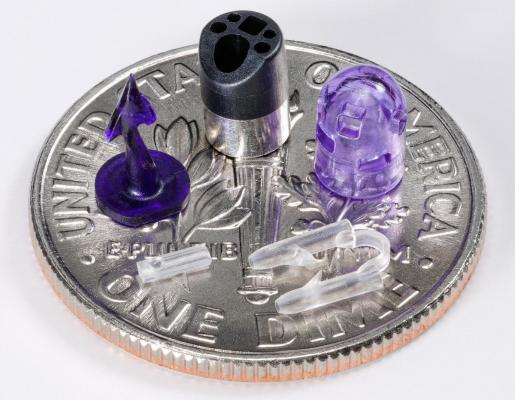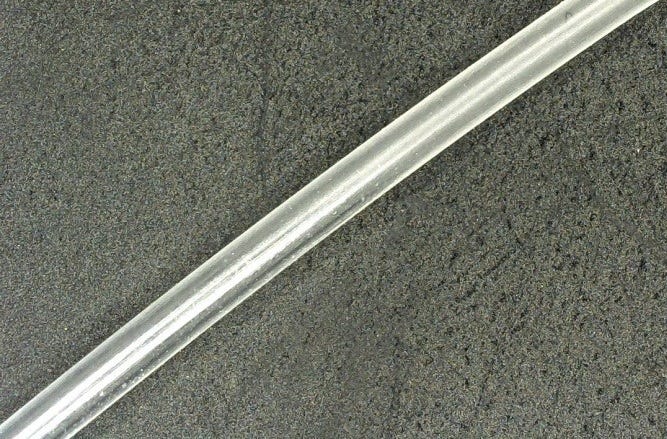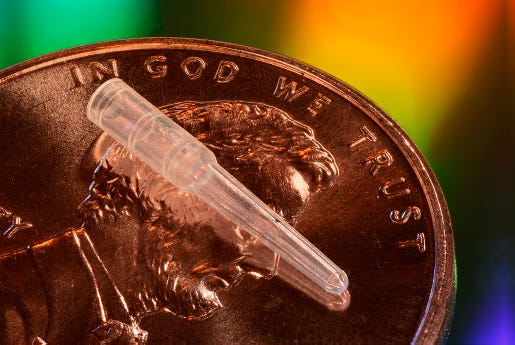OEMs can turn to micromolding to help cut costs and enhance performance of drug-delivery devices. Lindsay Mann
November 20, 2015

OEMs can turn to micromolding to help cut costs and enhance performance of drug-delivery devices.
Lindsay Mann
Micromolding can produce parts that are much smaller and more detailed than those possible to make using traditional molding processes. |
The area of drug delivery is seeing an influx of innovation, with new solutions aimed at making the process of administering drugs to patients more convenient, painless, and effective. One manufacturing process playing a key role in this evolution is micromolding, an injection molding method that starts with a part that has features you cannot see with the naked eye. You need a microscope to see the part itself and/or the fine detail of the part's features.
Medical device companies are working with micromolders to help set the new standard for manufacturing drug-delivery components, achieving advantages including elimination of assembly steps, improved dimensional stability, reduced production costs and more.
Eliminate Assembly Steps
|
Shown is a polypropylene, thin-walled, micromolded part with a 0.005-in. long-distance wall. It is extremely difficult to make a long, thin, straight part because it can only work if a tiny, delicate core pin is centered precisely in the cavity. |
Drug-delivery systems manufactured by traditional methods often require complex parts to be assembled together, which can be labor-intensive, risky, and costly. Combing a cannula and housing, for example, involves a series of high-risk, cumbersome assembly steps requiring a room full of people working at once.
Using micromolding, however, some of these troublesome components can be molded together at once, saving time and money while reducing risk. Working with a micromolder, the OEM can perform a mold flow analysis to see if this approach might be feasible for their specific application.
Reduce Material Costs
Cannula components are typically manufactured through a heat-forming process for converting fluoropolymer extrusions. However, this process is expensive and has a high fallout rate. Fluoropolymers are known for their chemical resistance, lubricity, and heat resistance, but they are shear-sensitive. Because of those properties, they are uniquely suited for being heat-formed but not good candidates for thin-wall molding applications, such as cannulas.
Polypropylene, on the other hand, is a material that also has great chemical resistance and lubricity but is not shear-sensitive. While polypropylene cannot be heat-formed, it offers much better melt flow in thin-walled applications.
While polypropylene is likely to be used increasingly for cannula components going forward, some OEMs may fear switching materials midstream, which can involve a costly reapproval process. However, in the long term, savings from making the switch from fluoropolymers to polypropylene can far outweigh this cost.
More Uniform Parts
In terms of technical execution, it can be difficult to make a long, thin, straight part such as a cannula. The challenge lies in the fact that for a 0.005-in wall thickness to flow long distance, a tiny, delicate core pin must be centered precisely in the cavity. With long length of thin flow, it is impossible to fill an annular ring if the material flow becomes uneven. When flow becomes unbalanced, a hydraulic effect is created on one side and pushes the core pin, which produces an ultrathin wall on the opposite side. This, in turn, causes fill problems and distortion.
|
The key feature of this polypropylene, thin-walled, micromolded micropipette tip is a 60-micron diameter (0.0024-in.), thin-walled exit hole with micron tolerances. |
Precise control over the position of the core is critical, which is why highly capable tooling and molding machines are required to successfully mold a thin-walled cannula. A highly specialized ability to create a mold capable of producing microsized plastic geometries and tolerances is critical, and the entire micromolding system must be designed to operate with closer precision molds than macromolding and real-time process monitoring.
Minimize Drug Loss
Some drug-delivery devices today are intended to administer an active drug compounded with a bioabsorbable material, with the carrier dissolving to deliver the drug over an extended period of time. While time-release drugs offer a welcome alternative to needle injections for patients, they also pose challenges for manufacturers. The extrusion process, for example, can lead to a high level of active drug loss. Further complicating matters, test batches of the compounded material containing the active drug can be very expensive, so conservation and proper handling of the material is critical.
Micromolding can help minimize active drug loss by utilizing precise molding equipment and consistent, tightly controlled molding parameters that do not jeopardize the integrity of special compounded materials.
Dimensional Control
With time-release drugs, maintaining extremely tight tolerances of critical dimensions is critical to the delivery device's function because the amount of material making up the part is directly related to the drug dosage. Dimensional control for these tiny micromolded components, which can be about one-third the size of a grain of rice, requires highly precise molding equipment. If not molded correctly, it can cause problems in the secondary manual assembly step.
The key to success is using standardized equipment that is customized to optimize inherent viscosity loss. High-precision machines that are less abusive to sensitive materials enable extremely high control of critical processing parameters.
Conclusion
The market for drug-delivery devices is expanding rapidly. The ability to produce cannulas with extremely thin walls and ultraprecise drug-delivery components that historically have not been able to be traditionally molded is key to this development. As OEMs continue to move toward providing more convenient, painless, and effective drug-delivery devices to patients, they will increasingly need to rely on micromolding to produce the components these devices require.
See MTD Micro Molding at booth #843 at the BIOMEDevice San Jose expo, December 2-3, 2015, at the San Jose Convention Center. |
Lindsay Mann is director of marketing at MTD Micro Molding. Reach her at [email protected].
[images courtesy of MTD MICRO MOLDING]
You May Also Like




